demonstrate how your product can solve it; give a money-back guarantee; include the price; and ask for the order, explicitly and urgently. The demonstrations should promise not one benefit, but several. (This runs counter to the Procter & Gamble formula.) My partner Al Eicoff has had more experience than anyone in selling direct on television. He has almost never seen a commercial shorter than two minutes produce profitable sales. These marathon commercials don’t seem to irritate people as much as a cluster of short ones – ‘like five salesmen knocking on the door, one after another.’ You must allow 20 seconds to give information on how to order. This is long enough to give your toll-free telephone number and post office box number, complete with supers; and to repeat the charge-free telephone number at least twice. Most advertisers measure their purchases on television time by cost per thousand viewers reached, but Eicoff measures them by the number of orders he receives each time a station broadcasts one of his commercials. He then eliminates the time periods and the stations that don’t pay off. The most productive times are early morning, late evening and weekends. January, February and March are the most profitable months. The better the program on which your commercials appear, the fewer sales you make. When viewers are bored by an old movie, they are more likely to pick up the telephone and order your product than when they are riveted by an episode of Dallas. Remember, there is no correlation between the size of your audience and the number of orders you receive. Every chapter in this book is of necessity an over-simplification of a more-or-less complicated subject, and no more so than this one. If you want to know more about direct response, start by reading Successful Direct Marketing Methods by Bob Stone, published by Crain Books in Chicago.
 Ogilvy on Advertising Page 213 Page 215
Ogilvy on Advertising Page 213 Page 215